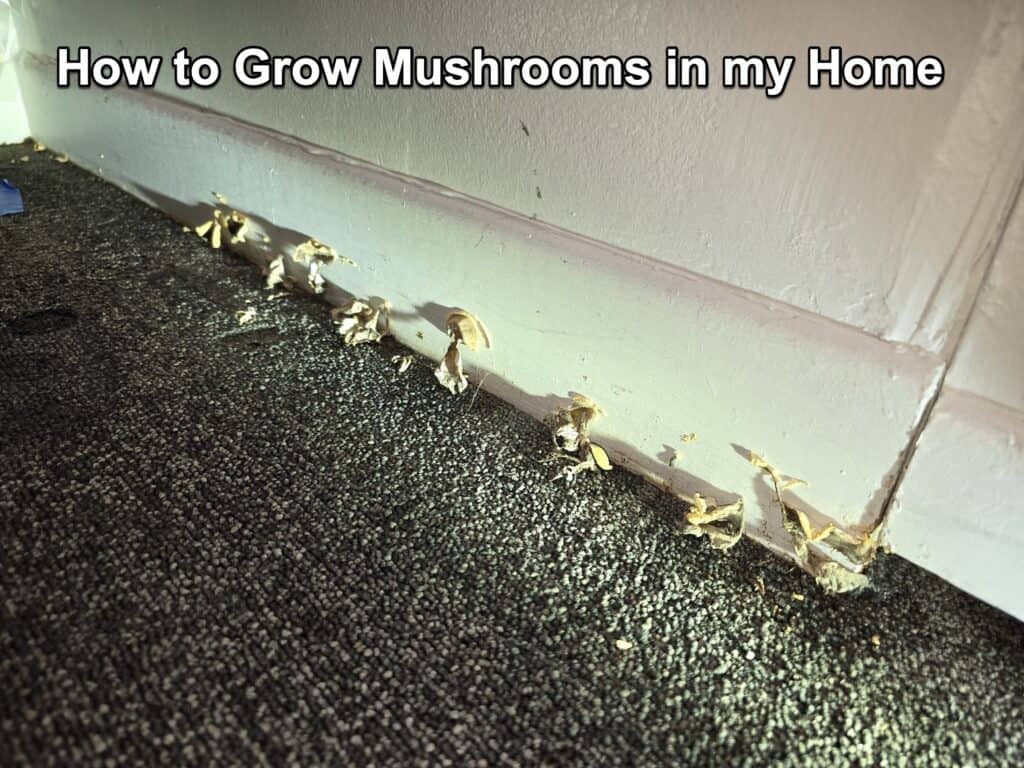
This isn’t your edible mushroom.
If mushrooms are growing indoors, particularly on the carpet or base of interior walls, it typically indicates a significant moisture issue. In terms of moisture intrusion categories, this situation would likely fall under Category 2 or Category 3.
Category 2 water, according to the IICRC S500 Standard and Reference Guide for Professional Water Damage Restoration, refers to water that is significantly contaminated and may cause illness or discomfort if ingested or exposed to skin. It’s also known as “grey water.” Category 2 water does not contain sewage but may contain contaminants such as chemicals, microorganisms, or other substances that can pose health risks.
Examples of sources of Category 2 water include:
- Discharge from dishwashers or washing machines.
- Overflows from toilet bowls with urine (no feces).
- Overflows from sump pumps.
- Seepage due to hydrostatic pressure.
- Broken aquariums or waterbeds.
- Broken water pipes containing relatively clean water.
While Category 2 water is not as immediately hazardous as Category 3 (black water), it still requires caution and proper cleanup procedures to prevent health risks and further damage. When dealing with Category 2 water intrusion, it’s essential to wear appropriate personal protective equipment and follow industry-standard guidelines for cleaning and disinfection. In some cases, professional restoration services may be necessary to ensure thorough and safe cleanup.
Category 3 moisture intrusion involves water that is grossly contaminated and can cause severe illness or death if consumed by humans. This can include water from sewage backups, flooding from rivers or streams, toilet overflows with feces, and other highly contaminated sources. If mushrooms are growing due to Category 3 moisture intrusion, it suggests a severe and potentially hazardous situation that requires immediate attention and professional remediation.
In either case, addressing the underlying moisture issue is crucial to prevent further fungal growth and potential health risks associated with contaminated water. It’s essential to identify and eliminate the source of moisture, thoroughly clean and dry the affected area, and possibly remove and replace any water-damaged materials. Professional assistance may be necessary, especially for Category 3 situations, to ensure proper cleanup and restoration.
Removing mushrooms growing inside your home should be done with caution to prevent spreading spores and causing potential health hazards. Here’s a step-by-step guide on how to safely remove mushrooms:
- Wear Protective Gear: Before handling the mushrooms, put on gloves, a mask, and possibly eye protection to minimize exposure to spores and any potential allergens or toxins.
- Ventilate the Area: Open windows and doors to improve ventilation in the affected area. This helps reduce the concentration of airborne spores and any associated odors.
- Remove Mushrooms: Carefully pluck the mushrooms from their base, ensuring that you remove as much of the fungus as possible. Avoid disturbing the mushrooms more than necessary to prevent spore release.
- Dispose of Mushrooms: Place the mushrooms in a plastic bag and seal it tightly to contain any spores. Dispose of the bag in an outdoor trash bin immediately to prevent further spread indoors.
- Clean the Area: Thoroughly clean the area where the mushrooms were growing using a mild detergent or a mixture of water and vinegar. Scrub the affected surfaces to remove any remaining traces of the fungus.
- Dry the Area: After cleaning, dry the area completely to prevent moisture buildup, which can encourage further fungal growth. Use fans or dehumidifiers to expedite the drying process if necessary.
- Inspect for Moisture Sources: Investigate and address any underlying moisture issues that may have contributed to the mushroom growth. This may involve fixing leaks, improving ventilation, or reducing humidity levels in the home.
- Monitor for Regrowth: Keep an eye on the area where the mushrooms were removed and watch for any signs of regrowth. If mushrooms reappear, it may indicate that there’s still a moisture problem that needs to be addressed.
- Consider Professional Help: If the mushroom growth is extensive or if you’re unsure about how to safely remove them, consider seeking assistance from a professional mold remediation service.
By following these steps, you can safely remove mushrooms from inside your home and take measures to prevent their recurrence. Remember to prioritize safety and proper hygiene throughout the removal process.

